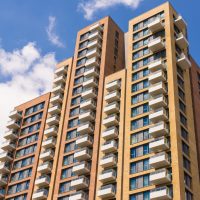
The body found that without government intervention it would take a decade for private landlords to make their buildings safe.
Complications around obscure and offshore ownership structures was one of the factors delaying work being undertaken.
And it is expected to take until the middle of 2022 to complete the work under the government’s brief – two years longer than was originally forecast.
Only 12 per cent spent
The Investigation into remediating dangerous cladding on high‑rise buildings report looked into the Ministry of Housing, Communities & Local Government’s (MHCLG) progress and found that in terms of remediation and identifying unsafe buildings, the private sector was falling behind the social sector.
In comparison, the NAO found that as of the end of April 2020, MHCLG had paid out £133m from its social sector fund, representing 33.3 per cent of the total £400m which was made available in May 2018.
The £200m fund for the private sector was announced a year later and in March, a further £1bn Building Safety Fund was made available. The department intends to commit the total fund by the end of March 2021.
As of April, the department has approved private sector applications worth a further £24.98m or 12.5 per cent of the total fund.
The report also revealed the government modelled a counterfactual ‘do nothing’ approach that would take a decade to complete the work.
It found in the absence of funding, private building owners would remediate buildings by themselves as part of general maintenance by March 2030.
MHCLG expects to pay for 94 projects out of 208 in the private sector, where the developer or building owner has not agreed to fund remediation works themselves.
Slower private sector progress
NAO found that the pace of remediation was faster in the student accommodation and social housing sectors, but slower in the private residential sector.
As of April 2020, 66 per cent of student accommodation blocks and 47 per cent of social housing buildings had been fully remediated, compared with 14 per cent of private sector residential buildings.
Since the announcement of private sector funding in May 2019, 15 private residential buildings have been restored compared with 40 social sector residential buildings over an equivalent 11-month period.
According to the report, the department currently estimates that all buildings within scope of its funding schemes will be remediated by mid-2022, with more than 95 per cent completed by the end of 2021.
Identification and eligibility
MHCLG has been slower to identify unsafe buildings in the private sector with 297 high-rise buildings with aluminium composite material (ACM) cladding identified by June 2018 compared with the identification of 173 high-rise social sector buildings by September 2017.
Between December 2019 and April 2020, an additional 11 buildings were identified, confirmed and brought within scope of the private sector funding scheme.
It is also more difficult to determine who the owners of private high-rise buildings are, which NAO said impacted on the pace of some applications for funding.
This is because some buildings have complex ownership arrangements such as offshore investors.
Also, many buildings are mixed-use, with different layers of ownership and responsibilities, for example buildings where some properties are reserved for affordable housing and while others are owned by residential and commercial leaseholders.
A single legally responsible entity for the entire building has to be identified in order to progress with an application for funding.
Private sector owners also have to go through more checks to complete applications for funding, as while social sector owners can self-certify, private owners can not.
Private sector owners must also include State Aid declarations, which must be filled out by all leaseholders in each building. The report found MHCLG believes that the additional checks are necessary to safeguard public money and the legality of the private sector funding scheme.
Wider complications
The report found that the department was aware of complicating factors which could slow down remediation progress.
For example, where unsafe cladding makes up a fundamental part of the external walls in new-build properties this could complicate and delay any construction works.
Also, the location of a building can cause difficulties, such as properties which are backed onto a railway.
In many cases inspection of cladding has revealed other flaws in construction and fire safety, but the department is not funding these.
MHCLG has been depending on building owners’ forecasts of when their remediation works will be completed, and where building owners have not suggested a completion date it is making assumptions based on completion times for buildings already remediated.
The report revealed that forecast for full remediation of all buildings by mid-2022 goes beyond former secretary of state James Brokenshire’s expectation set out in July 2019, where he said all building owners should complete remediation by June 2020.
Furthermore, MHCLG told NAO that remediation work on some sites has been more complex than initially anticipated as it noted a shortage of skills and available contractors.
The department aims to speed up remediation by supporting local authorities in undertaking enforcement action against building owners, engaging with building owners, and providing construction and project management expertise.
Effects of Covid-19 on construction were also mentioned, and NAO found that 60 per cent of projects were put on pause after the country went into lockdown on 23 March.
Public safety
MHCLG estimates there to be around 85,000 buildings between 11 and 18 metres in the UK, but does not yet have data on how many of these have cladding systems, or what proportion might be unsafe ACM cladding.
The department also has no data on the number of care homes under 18 metres with such cladding, or other buildings with a high concentration of elderly or vulnerable residents.
It said it will begin a data collection exercise for buildings between 11 and 18 metres this summer.














